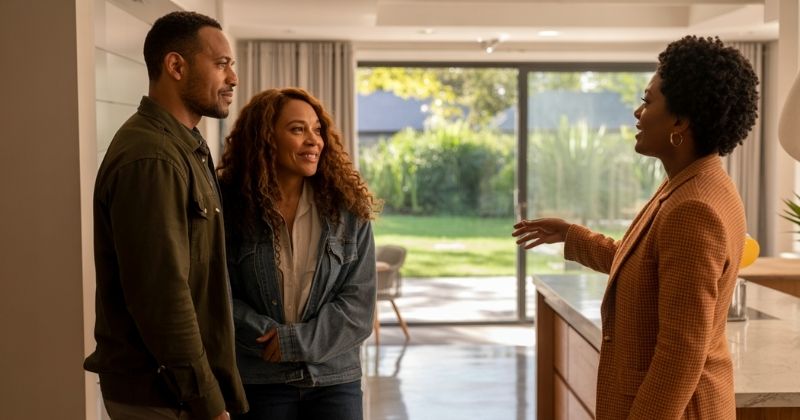
The South African housing market faces significant challenges, with rising property prices outpacing wage growth and making home ownership increasingly difficult for many households. Limited housing supply, escalating construction costs, and weak economic growth have combined to place additional pressure on low- and middle-income earners. At the same time, regulatory delays, labour constraints, and high service charges further restrict affordability.
Key Takeaways
- Falling Interest Rates: The prime lending rate has dropped by 100 basis points since September 2024, reducing borrowing costs and making homes more affordable for buyers and investors.
- Strong Demand vs Limited Supply: South Africa faces a housing shortfall of 2.3 million units, with semigration, foreign investment, and high rental demand in coastal areas continuing to drive property purchases and investment.
- Structural Challenges Remain: Despite favourable financing conditions, economic stagnation, bureaucratic delays, and high construction costs keep many households priced out of the market, highlighting the need for policy reform and efficient land release.
About Arcadia Finance
Get the funds you need quickly with Arcadia Finance. Compare offers from 19 trusted lenders, pay no application fees, and borrow with confidence under NCR compliance.
An Overview Of South Africa’s Housing Market
The key drivers of the South African housing market remain rooted in interest rates, property supply and demand, location trends, and property categories. While these elements are not new, the balance has shifted considerably in favour of buyers and investors. At present, making use of a professional estate agent can provide valuable insight into local market conditions, ensuring that both buyers and investors take advantage of these improved circumstances.

Interest Rates
One of the most significant developments shaping the market has been the sharp reduction in interest rates, marking the most notable downward cycle in recent years.
Recent Interest Rate Adjustments:
| Date | Prime Lending Rate Change |
|---|---|
| September 2024 | Reduced from 11.75% to 11.50% |
| November 2024 | Second cut brought the rate down to 11.25% |
| January 2025 | Further adjustment lowered the rate to 11.00% |
| May 2025 | Latest cut moved the rate to 10.75% |
These four reductions equal a total decline of 100 basis points over an eight-month period. This means households now face lower monthly repayments, while new buyers are finding homes more affordable to finance.
Rates are falling because inflation has dropped to 2.8%, which is below the South African Reserve Bank’s target range, while slow economic growth has created the need for monetary stimulus, and a stronger rand has helped keep inflation under control. Analysts believe the prime lending rate could fall further to 10.50% by the end of 2025, with the possibility of additional 25 basis point cuts during the year.

Supply And Demand
Demand for property in South Africa continues to remain robust, with the country still facing a shortfall of 2.3 million housing units. This imbalance ensures strong conditions for both home purchases and investment opportunities.
Recent Market Indicators:
- Mortgage applications tend to be for investment or buy-to-let properties.
- First-time buyers currently account for 46.6% of applications nationally.
- Semigration to coastal areas and rising levels of foreign investment are further increasing demand.
Suburbs in Cape Town, such as the City Bowl, Atlantic Seaboard, and Southern Suburbs, are experiencing particularly strong rental demand due to the combination of undersupply and higher property costs. In the current low interest rate environment, buy-to-let investments in these regions are becoming especially appealing.

Popular Locations
Coastal regions remain a magnet for South Africans seeking a lifestyle change supported by remote and hybrid work models. With lower interest rates and ongoing semigration, coastal property investment continues to show strong long-term potential.
In urban centres, mixed-use developments are increasingly popular among younger professionals. These projects provide housing combined with on-site facilities such as gyms, co-working areas, and cafés. This structure supports a work-life balance while still maintaining access to city services and entertainment.
Meanwhile, upmarket areas in Cape Town have continued to attract both local and international buyers. Despite higher entry prices, these areas benefit from a combination of tourist demand and a weaker rand, making South African property more appealing for overseas investors.

Popular Property Types
Residential housing remains the preferred choice for buy-to-let investors, particularly as the prime rate now sits at 10.75%, making repayments more manageable than in previous years.
For those looking for higher yields, commercial property offers greater returns, with capitalisation rates at around 11%, compared with 5% to 8% for residential property.
Breakdown of commercial segments:
- Retail properties represented about 30% of all transactions in 2023 and 2024.
- Industrial properties remain in demand due to limited supply.
- Office complexes and warehouses attract committed tenants and allow for longer leases.
Banks typically finance up to 75% of commercial property purchases, so investors are expected to provide higher upfront contributions compared with residential property.
Another rapidly growing opportunity lies in student accommodation. With an estimated shortage of more than 500,000 beds nationally, there is clear demand for affordable housing close to tertiary institutions. The average financing requirement per bed is around R54,000 annually, yet student funding only ranges between R31,000 and R35,000, leaving a significant gap that investors can address.

Trends Affecting South Africa’s Housing Market
Sustainability and Green Building Practices
The proportion of new developments with green certification has grown from 7% in 2016 to 32% in 2020, highlighting how environmental awareness is shaping housing choices. Surveys such as the Absa Homeowners Sentiment Index reveal that South Africans are placing greater value on eco-friendly features when buying or improving property. Developers, however, face the challenge of high upfront costs that weigh on short-term returns, even though green-certified prime offices consistently outperform conventional buildings by offering lower operating costs, higher income growth, and stronger capital appreciation.
This shift reflects a broader market adjustment where sustainability is increasingly linked to financial resilience. Partnerships are also making environmentally conscious homes more accessible. For example, Absa has partnered with the International Finance Corporation (IFC) to encourage green housing, allowing eligible homebuyers to receive rebates of between 1.5% and 3% of their loan amount. Such initiatives help offset costs and broaden access to sustainable living, reinforcing long-term environmental and financial benefits.
Remote Work and Shifting Space Demands
Remote and hybrid work patterns have reshaped residential property demand, with buyers prioritising larger suburban homes that can accommodate offices, strong internet connections, and lifestyle amenities. This shift has led to rising interest in suburban markets where space and adaptability better support flexible working arrangements compared with compact properties near traditional business centres.
Commercial property trends also reflect these adjustments. SAPOA’s latest survey shows office vacancies improving for eight straight quarters, with prime offices seeing the greatest gains. Rental declines are stabilising, and investors are now focusing less on square footage and more on quality, technology readiness, and adaptability of office spaces. Offices in prime locations that provide modern, flexible layouts are expected to retain long-term value, shaping investment strategies in the years ahead.
E-Commerce and the Transformation of Retail Real Estate
While the rise of online shopping has changed consumer behaviour, brick-and-mortar retail remains significant in South Africa. Lightstone reported that retail property made up around 30% of all commercial transactions last year, with a total value of R15.8 billion, making it the most active sector. At the same time, many retailers are shifting to hybrid models where physical outlets double as showrooms and distribution centres, helping them meet the expectations of online customers.
The e-commerce boom is also boosting demand for industrial spaces like warehouses and last-mile delivery hubs, particularly in under-served areas such as townships and rural regions. Well-located centres with a strong base of non-discretionary spending continue to perform reliably, which strengthens loan-to-value capacity for investors. Together with interest rate cuts that reduce borrowing costs, these conditions create a favourable outlook for growth and sustained profitability in retail real estate.

South Africa’s Housing Affordability Crisis
A large proportion of South African households are unable to purchase property, and the situation is deteriorating. Housing shortages are widespread, while rising construction costs have made newer developments increasingly out of reach for ordinary buyers. For decades, property values have risen faster than wages, both in South Africa and in other countries, leaving households struggling to enter the housing market.
Weak economic growth in South Africa has worsened the problem. Limited job creation and stagnant wages mean that low- and middle-income earners face growing barriers to home ownership.
National Changes
There are structural issues outside the property market that must be addressed before housing affordability can improve.
| Category | Key Issues & Insights |
|---|---|
| Economic Growth | South Africa needs consistent, sustainable policies that drive growth. Misuse of public funds and inflated executive salaries at failing state-owned entities reduce resources available for housing and infrastructure. |
| Structural Reform | Investment inflows are mainly short-term portfolio investments, not long-term commitments that create jobs or infrastructure. Greater emphasis is needed on productive investment to build industrial capacity. |
| Vocational Training | Skilled artisans are being lost faster than they can be replaced. This shortage raises construction costs, making homes less affordable. Reindustrialisation is required, with more focus on trades like electricians, plumbers, and technical professions. |
| Restrictive Labour Policies | Current labour laws make employment costs higher than in other developing nations. Liberalisation, currency adjustments, and reduced import reliance could stimulate job creation. While wages may dip initially, broader employment would eventually drive economic expansion and wage recovery. |
Implementing such changes on a national scale would not only improve conditions in the housing market but also contribute to a stronger, more balanced economy.
Property Market Changes
Alongside broader economic challenges, the property market itself is affected by structural and regulatory obstacles that make construction more expensive and homes less affordable.
| Category | Key Issues & Insights |
|---|---|
| Bureaucratic Delays | Excessive regulation and lengthy approval processes increase costs and slow down housing development. Streamlined systems are needed to reduce delays and attract investment. |
| Community Opposition (NIMBYism) | Resident objections, often through legal means, frequently delay or block proposed housing developments, restricting new supply. |
| Fixed Service Charges | High municipal and utility connection fees, such as for electricity, disproportionately burden lower-income households, making housing less affordable and raising default risks. |
| Limited Small-Unit Development | Developers avoid building smaller, affordable units because kitchens and bathrooms are costly, and sales effort is the same as for larger units. Targeted tax incentives and land access could encourage such projects. |
| Slow Land Release | Access to development land is constrained by lengthy processes. Municipalities could accelerate projects by preparing peripheral land in advance and conducting environmental assessments concurrently. |
| Finance and Rental Protections | Inefficient eviction and foreclosure systems discourage banks and landlords from investing in housing finance. Balanced procedures are needed to protect consumers while ensuring continued investment. |
Conclusion
The South African housing market presents a mixed picture. Falling interest rates and continued demand create favourable conditions for buyers and investors, particularly in coastal and urban areas. However, structural challenges such as limited housing supply, slow land release, restrictive labour laws, and rising construction costs continue to make affordability a pressing concern for many households. Long-term solutions will require both policy reform and efficient market adjustments to ensure housing opportunities are accessible across all income levels.
Frequently Asked Questions
Property demand is driven by semigration to coastal areas, foreign investment, and a national housing shortfall of around 2.3 million units. These factors keep demand strong despite affordability challenges.
The prime lending rate has dropped from 11.75% to 10.75% between September 2024 and May 2025. This means households pay lower monthly instalments, making home loans more manageable.
Residential property remains the most common investment, but commercial real estate offers higher returns, with capitalisation rates around 11% compared with 5% to 8% for residential. Student accommodation is also growing due to a shortage of more than 500,000 beds nationally.
Government policy influences affordability through labour regulations, land release processes, and housing incentives. Streamlined approvals and targeted tax breaks could reduce costs and increase the supply of affordable housing.
Remote and hybrid work have shifted demand towards larger suburban and coastal homes, while younger professionals prefer mixed-use urban developments that combine housing with facilities like gyms and co-working spaces.
Fast, uncomplicated, and trustworthy loan comparisons
At Arcadia Finance, you can compare loan offers from multiple lenders with no obligation and free of charge. Get a clear overview of your options and choose the best deal for you.
Fill out our form today to easily compare interest rates from 19 banks and find the right loan for you.



